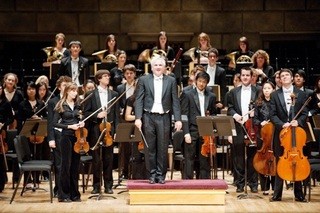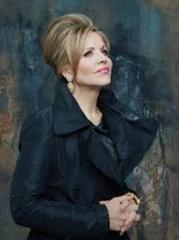|
Back
In-Toning the Painter’s Words New York
Alice Tully Hall, Lincoln Center
11/14/2016 -
Maurice Ravel: Rapsodie espagnole
Kevin Puts: Letters from Georgia
Sergei Prokofiev: Symphony No. 5, opus 100
Renée Fleming (Soprano)
Eastman Philharmonia, Neil Varon (Conductor)

N. Varon, Eastman Philharmonia (© Courtesy of the Artists)
The last appearance from the Eastman School of Music student orchestra here was a quarter-century ago. Since that time, most of those players have gone on to distinguished careers playing, teaching and writing. Yet no alumni of Eastman have been more distinguished than soprano Renée Fleming and composer Kevin Puts. Commissioning the splendid Mr. Puts with the still ravishing Ms. Fleming and the Eastman Philharmonia was a stroke of pure inspiration.
True this student orchestra under their energetic highly experienced conductor Neil Varon, played two other works, perhaps programmed to show off the young soloists and the ensemble. And true, the soloists–the Concertmaster, the fine brass section and almost violent percussion in the Prokofiev Fifth–were outstanding. But as a whole, the Eastman Philharmonia doesn’t hold a candle to our own Juilliard student ensembles.
I don’t believe that’s merely local prejudice on my part. The Juilliard Orchestra–-or rather the many orchestras of the school–have, of course greater opportunities here. But whether it’s the period ensembles or Joel Sachs and the students playing 21st Century music, the Juilliard students have an energy, an élan, a sense of vigor which the Eastman Philharmonia could never approach.
Not that the Rochester group, with their international personnel was sluggish in any way. But conductor Varon was so intent in keeping them precisely right that one didn’t sense the life, the youthful liveliness which one comes to expect.
That was especially true in Ravel’s early Rapsodie espagnole We all know Ravel insisted that the notes spoke for themselves, that one should never take liberties. Yet this was still a picture of Iberia, one in which he perhaps unconsciously was competing with Debussy’s Spanish fixation.
(Ravel had the Basque bloodlines, while Debussy never even visited Spain!)
Yet this opening, played quite perfectly was less mystery than torpor. The following two dances were conducted with pinpoint accuracy, but only the titles could signify they were from Malacca and...er, Cuba. (Bizet wonderfully but inaccurately made it a Spanish dance.) It was a correct performance, hardly an endearing one.
The Prokofiev Fifth was given more excitement, yet, even more than the Ravel, it plays itself. And these young people made nary a mistake. Yet this is played so frequently in New York that it was difficult to get excited about this performance.
No, this concert belonged exclusively to Ms. Fleming and Mr. Puts and Letters from Georgia.

R. Fleming (© Courtesy of the Artist)
The “Georgia” was painter Georgia O’Keefe, and her thousands of letters, many edited by the late Clive Giboire, were caviar for the inspiration of Kevin Puts.
The Texas-born composer, teaching now at Peabody, had two previous works here both outstanding in different ways. First, musically, of course. He is a lyrical composer who has an unfailing way of offering an emotional life while–like Maurice Ravel–being as utterly precise in his composition.
But also Mr. Puts creates in alliance with other forms. His music for a film, The City was subtle, so subtle that the movie overwhelmed his great gifts. But his Credo written for the Miro Quartet, was like an invitation to the dance, a light and joyous work.
Here, Mr. Puts had the challenge of being the tertiary artist. First, Ms. O’Keefe herself, had the painter’s vision (and painter’s adoration of her photographer husband). Then, rather than the easel, she set her painter’s sensibility to words in her letters.
Mr. Puts himself an admirer of O’Keefe, had the Augean task of sorting out these letters to give his musical aura to painted words. Sensibly, he arranged them in five philosophically chronological sections for the song cycle. First Ms. O’Keefe’s youthful yearning to be free after seeing Native American dances and riders. Then the painter belittling herself playing the violin (a short witty section with the dissonance of wrong fingers on the wrong string). Fourth was an amazing letter where Ms. O’Keefe questions what friendship is. And fifth, a metaphorical letter about death, Canyon, “Tonight I walked into the sunset. The whole sky–was just blazing–….I walked out past the last house–the locust tree–and sat on a fence for a long time...”
But Mr. Puts’ genius reached its zenith in the third and longest section, Ache, about her love for her soon-to-be husband. At first, it resembled Ms. Fleming’s oh-so-passionate aria, “Ain’t it a pretty night” from Carlisle Floyd’s Susannah. But Mr. Puts isn’t into pure passion. His orchestra can rise up into ethereal heights, or silences with piano solo–or even jaunty Americana.
Yet this was a music which both fit the words, which were exciting without overwhelming the words, and which had that unfailing sense of Kevin Puts the musical painter notating the words of the painter herself.
As to Ms. Fleming, she, like Mr. Puts, has been that most careful of singers. She is carefully minimizing her opera performances, yet her recitals are never ever the usual arias. Mr. Puts wrote much of her music in Mr. Fleming’s middle range, yet when necessary she soared up to the top.
It was a splendid performance from two splendid artists who know that their range, their voice (both compositional and vocal) and their inspiration is bring radiance to their audience. And the standing ovation from the nearly sold-out audience, was well deserved.
Harry Rolnick
|